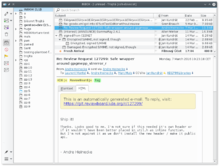Internet Services
Internet Services
The World Wide Web has been central to the development of the Information Age and is the primary tool billions of people use to interact on the Internet. Web pages are primarily text documents formatted and annotated with Hypertext Markup Language (HTML).In addition to formatted text, web pages may contain images, video, audio, and software components that are rendered in the user's web browser as coherent pages of multimedia content.The World Wide Web (abbreviated WWW or the Web) is an information space where documents and other web resourcesare identified by Uniform Resource Locators (URLs), interlinked by hypertext links, and can be accessed via the Internet.English scientist Tim Berners-Lee invented the World Wide Web in 1989. He wrote the first web browser computer program in 1990 while employed at CERN in Switzerland. The Web browser was released outside CERN in 1991, first to other research institutions starting in January 1991 and to the general public on the Internet in August 1991.
E-mail
World Wide Web
The World Wide Web has been central to the development of the Information Age and is the primary tool billions of people use to interact on the Internet. Web pages are primarily text documents formatted and annotated with Hypertext Markup Language (HTML).In addition to formatted text, web pages may contain images, video, audio, and software components that are rendered in the user's web browser as coherent pages of multimedia content.The World Wide Web (abbreviated WWW or the Web) is an information space where documents and other web resourcesare identified by Uniform Resource Locators (URLs), interlinked by hypertext links, and can be accessed via the Internet.English scientist Tim Berners-Lee invented the World Wide Web in 1989. He wrote the first web browser computer program in 1990 while employed at CERN in Switzerland. The Web browser was released outside CERN in 1991, first to other research institutions starting in January 1991 and to the general public on the Internet in August 1991.
Embedded hyperlinks permit users to navigate between web pages. Multiple web pages with a common theme, a common domain name, or both, make up a website. Website content can largely be provided by the publisher, or interactively where users contribute content or the content depends upon the users or their actions. Websites may be mostly informative, primarily for entertainment, or largely for commercial, governmental, or non-governmental organisational purposes.
Electronic Mail (email or e-mail) is a method of exchanging messages between people using electronic devices. Email first entered limited use in the 1960s and by the mid-1970s had taken the form now recognized as email. Email operates across computer networks, which today is primarily the Internet. Some early email systems required the author and the recipient to both be online at the same time, in common with instant messaging. Today's email systems are based on a store-and-forward model. Email servers accept, forward, deliver, and store messages. Neither the users nor their computers are required to be online simultaneously; they need to connect only briefly, typically to a mail server or a webmail interface, for as long as it takes to send or receive messages.
Originally an ASCII text-only communications medium, Internet email was extended by Multipurpose Internet Mail Extensions (MIME) to carry text in other character sets and multimedia content attachments. International email, with internationalized email addresses using UTF-8, has been standardized, but as of 2017 it has not been widely adopted.
The history of modern Internet email services reaches back to the early ARPANET, with standards for encoding email messages published as early as 1973 (RFC 561). An email message sent in the early 1970s looks very similar to a basic email sent today. Email had an important role in creating the Internet,and the conversion from ARPANET to the Internet in the early 1980s produced the core of the current services.
Instant Messaging
Instant messaging (IM) is a type of online chat that offers real-time text transmission over the Internet. A LAN messenger operates in a similar way over a local area network. Short messages are typically transmitted between two parties, when each user chooses to complete a thought and select "send". Some IM applications can use push technology to provide real-time text, which transmits messages character by character, as they are composed. More advanced instant messaging can add file transfer, clickable hyperlinks, Voice over IP, or video chat.
Non-IM types of chat include multicast transmission, usually referred to as "chat rooms", where participants might be anonymous or might be previously known to each other (for example collaborators on a project that is using chat to facilitate communication). Instant messaging systems tend to facilitate connections between specified known users (often using a contact list also known as a "buddy list" or "friend list"). Depending on the IM protocol, the technical architecture can be peer-to-peer (direct point-to-point transmission) or client-server (an Instant message service center retransmits messages from the sender to the communication device).
Voice Over Internet Protocol (VoIP)
Voice over Internet Protocol (also voice over IP, VoIP or IP telephony) is a methodology and group of technologies for the delivery of voice communications and multimediasessions over Internet Protocol (IP) networks, such as the Internet. The terms Internet telephony, broadband telephony, and broadband phone service specifically refer to the provisioning of communications services (voice, fax, SMS, voice-messaging) over the public Internet, rather than via the public switched telephone network (PSTN).
The steps and principles involved in originating VoIP telephone calls are similar to traditional digital telephony and involve signaling, channel setup, digitization of the analog voice signals, and encoding. Instead of being transmitted over a circuit-switched network, the digital information is packetized, and transmission occurs as IP packets over a packet-switched network. They transport media streams using special media delivery protocols that encode audio and video with audio codecs, and video codecs. Various codecs exist that optimize the media stream based on application requirements and network bandwidth; some implementations rely on narrowband and compressed speech, while others support high-fidelity stereo codecs. Some popular codecs include μ-law and a-law versions of G.711, G.722, an open source voice codec known as iLBC, a codec that only uses 8 kbit/s each way called G.729, and many others.
Early providers of voice-over-IP services offered business models and technical solutions that mirrored the architecture of the legacy telephone network. Second-generation providers, such as Skype, built closed networks for private user bases, offering the benefit of free calls and convenience while potentially charging for access to other communication networks, such as the PSTN. This limited the freedom of users to mix-and-match third-party hardware and software. Third-generation providers, such as Google Talk, adopted the concept of federated VoIP—which is a departure from the architecture of the legacy networks.These solutions typically allow dynamic interconnection between users on any two domains on the Internet when a user wishes to place a call.
In addition to VoIP phones, VoIP is available on many personal computers and other Internet access devices. Calls and SMS text messages may be sent over mobile data or Wi-Fi.
Message Boards
An Internet forum, or message board, is an online discussion site where people can hold conversations in the form of posted messages. They differ from chat rooms in that messages are often longer than one line of text, and are at least temporarily archived. Also, depending on the access level of a user or the forum set-up, a posted message might need to be approved by a moderator before it becomes visible.
Forums have a specific set of jargon associated with them; example: a single conversation is called a "thread", or topic.
A discussion forum is hierarchical or tree-like in structure: a forum can contain a number of subforums, each of which may have several topics. Within a forum's topic, each new discussion started is called a thread, and can be replied to by as many people as so wish.
Depending on the forum's settings, users can be anonymous or have to register with the forum and then subsequently log inin order to post messages. On most forums, users do not have to log in to read existing messages.
File Transfer Protocol (FTP)
The File Transfer Protocol (FTP) is a standard network protocol used for the transfer of computer files between a client and server on a computer network.
FTP is built on a client-server model architecture and uses separate control and data connections between the client and the server.FTP users may authenticate themselves with a clear-text sign-in protocol, normally in the form of a username and password, but can connect anonymously if the server is configured to allow it. For secure transmission that protects the username and password, and encrypts the content, FTP is often secured with SSL/TLS (FTPS). SSH File Transfer Protocol (SFTP) is sometimes also used instead; it is technologically different.
The first FTP client applications were command-line programs developed before operating systems had graphical user interfaces, and are still shipped with most Windows, Unix, and Linux operating systems. Many FTP clients and automation utilities have since been developed for desktops, servers, mobile devices, and hardware, and FTP has been incorporated into productivity applications, such as web page editors.











Comments
Post a Comment